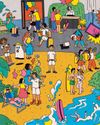
The snaking queue outside Maasaheb Meenatai Thackeray Hospital terrified Mariselvan Thevar. More than 200 people were in line, sagging in the heat as they coughed and wheezed. Some had come hoping to find a dose of coronavirus vaccine, which remains a scarce commodity in India. Others were trying to get their hands on medication, a bed, oxygen—anything.
A 21-year-old engineering student with a tall, lean frame and a patchy beard, Thevar thought he had little choice but to join the growing crowd outside the hospital, a small public facility in suburban Mumbai. His father, Kannan, had been ill for days. At 49, Kannan was far younger than the people who, for most of the pandemic, have experienced the worst outcomes from Covid-19. Yet Thevar grew increasingly anxious as they waited to be seen; his father was running a high fever, and even slight exertions left him breathless.
With just two overwhelmed doctors working, the hospital was allowing only a trickle of patients to enter its doors. After 10 hours in the baking sun, Thevar and his father were turned away. “The doctors were insisting patients go home, citing a shortage of beds, on the assurance that they will call them,” Thevar said. “They never call back.”
As the virus burns through India, this sense of futility and fear has become commonplace. The country is reporting nearly 400,000 confirmed infections and 4,000 deaths every day, tallies that are certain to be drastic undercounts. In Delhi, public parks have been requisitioned as makeshift crematoriums, with rows of funeral pyres burning where kids once played cricket. Hospital beds and oxygen cylinders are in short supply, as are doctors and nurses. Some researchers predict that the total number of fatalities—currently at 250,000—could top 400,000 by mid-June and then keep climbing.
Denne historien er fra May 17, 2021-utgaven av Bloomberg Businessweek.
Start din 7-dagers gratis prøveperiode på Magzter GOLD for å få tilgang til tusenvis av utvalgte premiumhistorier og 9000+ magasiner og aviser.
Allerede abonnent ? Logg på
Denne historien er fra May 17, 2021-utgaven av Bloomberg Businessweek.
Start din 7-dagers gratis prøveperiode på Magzter GOLD for å få tilgang til tusenvis av utvalgte premiumhistorier og 9000+ magasiner og aviser.
Allerede abonnent? Logg på

Instagram's Founders Say It's Time for a New Social App
The rise of AI and the fall of Twitter could create opportunities for upstarts

Running in Circles
A subscription running shoe program aims to fight footwear waste

What I Learned Working at a Hawaiien Mega-Resort
Nine wild secrets from the staff at Turtle Bay, who have to manage everyone from haughty honeymooners to go-go-dancing golfers.

How Noma Will Blossom In Kyoto
The best restaurant in the world just began its second pop-up in Japan. Here's what's cooking

The Last-Mover Problem
A startup called Sennder is trying to bring an extremely tech-resistant industry into the age of apps

Tick Tock, TikTok
The US thinks the Chinese-owned social media app is a major national security risk. TikTok is running out of ways to avoid a ban

Cleaner Clothing Dye, Made From Bacteria
A UK company produces colors with less water than conventional methods and no toxic chemicals

Pumping Heat in Hamburg
The German port city plans to store hot water underground and bring it up to heat homes in the winter

Sustainability: Calamari's Climate Edge
Squid's ability to flourish in warmer waters makes it fitting for a diet for the changing environment

New Money, New Problems
In Naples, an influx of wealthy is displacing out-of-towners lower-income workers